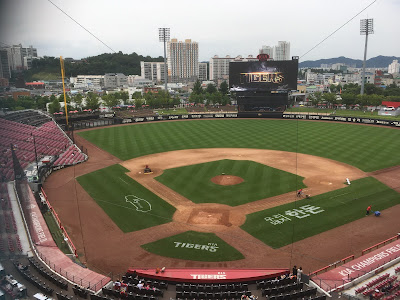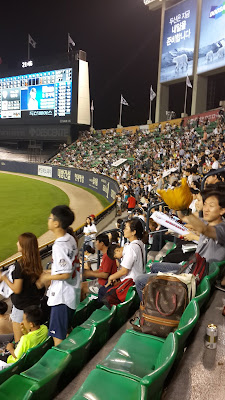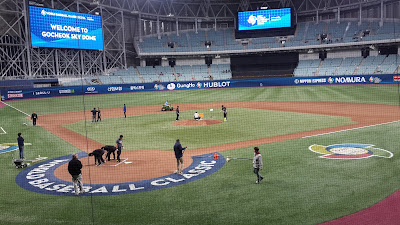"The saddest day of the year is the day baseball season ends" (Tommy Lasorda)
On Saturday, July 13th, 2019, the day before my latest birthday, I saw my last live baseball game, at Changwon NC Park. A muggy, yet perfect 74℉ (23℃) summer evening, with only a whisper of potential rain.
It was also the last destination in my Korean baseball stadium quest (kwest), which began on May 6, 2015, amid the cool days of spring at Hanbat Stadium in Daejeon, my home city in the center of the country, 104 miles to the west. Four years, nine stadiums, ten teams.
That July 2019 contest had all the elements I love in a good game - a raucous crowd, an outside venue, an as-of-yet-unseen stadium, and the heady promise of new adventures. I settled in with my scorebook along the third base side, to hear the Korean national anthem, Aegukga, played by a group of flutists, then headed up somewhere around the sixth inning to the upper decks also on the third-base side, just to catch a different perspective of the game and the fans.
The expansion NC Dinos were hosting the expansion KT Wiz and ended up getting pummeled that night, 13-3. The ninth inning was a bit of a disaster, as the Wiz scored four runs on three errors to blow an already ridiculous blowout wide open. Dino starter Drew Rucinski ended up going only four innings, before he was lifted, with his team down, 6-1. A lively group of 10,805 fans, including a fair number of Wiz faithful along the third-base side, half-filled the stadium. The cheerleaders danced, the Dino mascots ran about, and the announcers gave children in the home section microphones to announce upcoming batters.
But for all the antics on the field, the stadium was worth the trip in itself. Opened only in March of that year, it cost twice the average price of any other stadium I'd been to, 20,000 Won, but was worth every bit of it. As you walk up to the field, you ascend on ramps and staircases straight into the outfield bleacher area and are able to take everything in at once, gifted with a wide-open view of the entire layout. No other sports stadium in South Korea has this open-wide feel to it, as the rest of them are perfectly-enclosed like the big USA concrete bowl stadiums of the 1970's.
 It's also got the smallest potential home base in South Korea, in the ninth-largest city of only one million, closest to Busan in the southeast corner.
It's also got the smallest potential home base in South Korea, in the ninth-largest city of only one million, closest to Busan in the southeast corner.Changwon NC Park very much felt like some of my favorite ballparks in the U.S., so I was not surprised to find out later that the global architecture firm Populous was responsible for its construction (the same firm that spearheaded the retro construction period and produced Camden Yards in Baltimore, Progressive Field in Cleveland, and Minute Maid Park in Houston, among other places). This is the only baseball stadium that firm has designed in Korea.
The NC Dinos are also one of the more enigmatic teams in the league, an expansion franchise owned by the NCSoft video game development company (the rest of the teams are owned by the big corporations in the country). The Dinos began playing in 2013, and have made the playoffs five out of the franchise's first seven years. They even made it to the KBO series in 2016, but lost their so-far one and only chance to the Doosan Bears. They're back at it again this year, four games ahead of those same Bears in first place in the 2020 standings. That's an amazingly high yardstick they're holding up over the league.
 They also have personalities galore. One of their most famous alumni is third baseman Eric Thames, who went on to generate big buzz and big money in Milwaukee. Thames landed with the team in 2014, and put up some remarkable numbers, most notably 47 home runs and 40 stolen bases in 2015, becoming the first KBO player to hit 40 home runs and steal 40 bases in the same season. He won the MVP award in 2015 for this. He seemed to enjoy his time there.
They also have personalities galore. One of their most famous alumni is third baseman Eric Thames, who went on to generate big buzz and big money in Milwaukee. Thames landed with the team in 2014, and put up some remarkable numbers, most notably 47 home runs and 40 stolen bases in 2015, becoming the first KBO player to hit 40 home runs and steal 40 bases in the same season. He won the MVP award in 2015 for this. He seemed to enjoy his time there.In April 2016, Changwon apparently granted him honorary citizenship, and he responded by leading the team with another gigantic season (40 home runs) which took the team to the brink of a championship. Few players have made a bigger impact in the KBO, yet several now have followed in his wake to return to big money playing in the major leagues in the USA. One example is Josh Lindblom, former Doosan Bear now Milwaukee Brewer.
The 23-year-old lefty pitcher Koo Chang-mo is generating the most buzz right now for the Dinos, with his 6-0 record, and he's had plenty of help from two-year Dino veteran Rucinski (5-1) and newbie Mike Wright (6-2), as well as former Phillie center fielder Aaron Altherr, who's already hit 10 home runs, and is among the top five best foreign hitters in the league currently. Then there's 8-year Dino veteran Na Sung-bum, an outfielder/designated hitter, who hits in the middle of the lineup, and who's usually good for 20+ homers a year. The Dinos have talent.

And while that talent did not coalesce during that game in July 2019 (the Dinos left 12 men on base in a dismal offensive effort), they did make the playoffs later in the season as a wild card. And honestly, I was having too good a time wandering about this new stadium, observing all the little touches of Chez Dino. One standout structure that I couldn't help but notice was the gigantic beer garden-cafe overlooking left field, with several floors and porches overlooking the field. Down below, in back of the ground-level seating, there were wide open concourses, so you never felt cramped, and were always close to the action below. There were big lines for food, and heading into the gift shop at the end of the game. I resisted the urge to join the crowd and pick up a plush Dino.
There is a reason for the dinosaur-centric theme of Changwon, as the southern area of the country seems to be a dinosaur fossil hotbed (the Goseong Dinosaur Museum is also relatively close). Specific NC mascots include Seri, a green Brontosaurus that wears a necklace, and Dandi, a blue Tyrannosaurus. Yeah, that rocks about as hard as you think.
I had no idea what to expect from Changwon, the little sleepy port town modeled after Canberra, Australia, and even after staying there one night, I didn't learn enough about its main attractions, other than being on the coast, and their summer entertainers, the NC Dinos. All the motels seemed to be in one area, and it had a definite "working port" kind of vibe, much different from the upscale Busan. Apparently, the city has branded itself an "environmental capital." Further research on the city revealed copious thought put into the flag - a tri-coloured pinwheel made of 'C' shaped wings, including blue, symbolizing the ocean, growth, and hope; orange, representing passion and creation; and green for nature and balance. They've put a lot of thought into the town's bits and pieces.
After the game, I saw some of this "green aspect," as I wandered on the lamplit footpaths along the Haewancheon River, before settling back in my nearby motel for a nice, soothing post-game bath.
 Changwon seems like a nice enough place to be, and I've heard that it actually has a sizeable foreign community. On Sunday, my birthday, the day after the game, Pizzeria da' Genna (open since 1957!) served me one of the most satisfying Italian meals I've had in country, Pesto Mussels Vongole, and before I boarded the train, a Starbucks staffer gifted me a size bigger on my latte to compliment my cheesecake. Small little touches like these made great gifts on my big day.
Changwon seems like a nice enough place to be, and I've heard that it actually has a sizeable foreign community. On Sunday, my birthday, the day after the game, Pizzeria da' Genna (open since 1957!) served me one of the most satisfying Italian meals I've had in country, Pesto Mussels Vongole, and before I boarded the train, a Starbucks staffer gifted me a size bigger on my latte to compliment my cheesecake. Small little touches like these made great gifts on my big day.Full of cake and mussels, I waved goodbye to green and friendly Changwon, the NC Dinos, and boarded the train back to Daejeon, my Korean baseball stadium quest at an end.
---
Speaking of small gifts, I want to thank each and every reader who joined me for a few miles on my blogging baseball journey, and I hope this series carries on into the future as something to be discovered by others. I also hope all you readers can discover some magic in your own expectant journeys, your own quests.
Will this now long-ago 2019 birthday weekend game be the last one that I see? Time will tell.
I expect I will see others, perhaps even pursue, and eventually fulfill another baseball quest, but you never know. The next great disaster, the next daunting health crisis, the next sequestering world event, may be yet around the corner.
We must do what we can in the time we have.
The game is over, the lights are dimming.
It's time to go home.





































